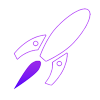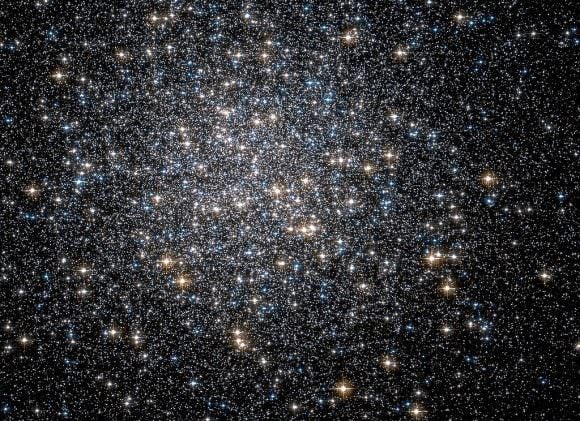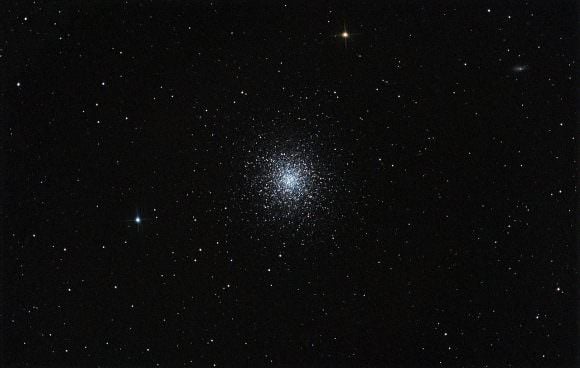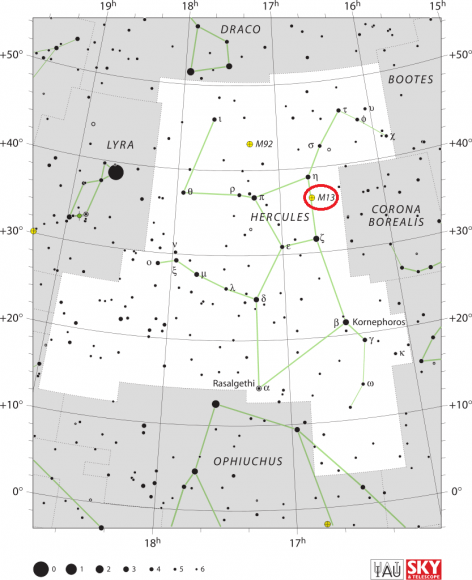Welcome back to Messier Monday! Today, in our ongoing tribute to Tammy Plotner, we take a look at the M13 globular cluster, which is often referred to as the Great Globular Cluster in Hercules. Enjoy!
In the 18th century, French astronomer Charles Messier began cataloging all the "nebulous objects" he had come to find while searching the night sky. Having originally mistook these for comets, he compiled a list these objects in the hopes of preventing future astronomers from making the same mistake. In time, the list would include 100 objects, and would come to be known as the
Messier Catalog
to posterity.
One of these objects is M13 (aka. NGC 6205) a globular cluster located in the
Hercules
constellation. Located some 25,100 light-years away from Earth, this cluster is made up of 300,000 stars and occupies a region of space that measures 145 light-years in diameter. Given its sheer size and its location, it is often referred to as the "Great Hercules Cluster".
Description:
This 11.65 billion year old formation of stars is one of the most impressive globular clusters in the northern hemisphere. Containing over 300,000 stars packed into a 145 light year sphere, the center of this glorious object is 500 times more concentrated than its outer perimeters. And out of all of those stars there stands one stranger - Barnard 29. This spectral type B2 star is a young, blue star that M13 is believed to have collected during one of its tours around the Milky Way Galaxy.
Other interesting finds include the 15 blue straggler star candidates and 10 other possible that have been spotted by the Hubble Space Telescope. The stars in the blue horizontal branch of M13 appeared to be centrally depleted relative to other stellar types and the blue stragglers in the combined sample are centrally concentrated relative to the older red giant stars.
[caption id="attachment_128814" align="aligncenter" width="580"]
The heart of the M13 Hercules Globular Cluster, viewed with the Hubble Space Telescope. Credit: ESA/NASA/HST
[/caption]
However, the Stromgren photometry work performed by
Frank Grundah (et al.)
suggests this is a normal occurrence in evolution. "We also note the existence of what appears to be two separate stellar populations on the horizontal branch of M13. Among other possibilities, it could arise as the result of differences in the extent to which deep mixing occurs in the precursor red giants."
In their 2002 study, "
An aligned stream of low-metallicity clusters in the halo of the Milky Way
", astronomers Yoon and Lee declared:
As to how old M13's stars are, there is more than one answer. According the work of R. Glebocki (et al), stellar rotation within Messier 13 can also play a role in how the stars age. As they state in their 2000 research study,
"Catalog of Projected Rotational Velocities"
:
[caption id="attachment_128818" align="aligncenter" width="580"]
Messier 13, as imaged by a DSLR camera. Credit: Wikipedia Commons/Rawastrodata
[/caption]
History of Observation:
M13 was originally discovered by Edmond Halley in 1714. In his notes, he wrote of the cluster: "This is but a little Patch, but it shews it self to the naked Eye, when the Sky is serene and the Moon absent."
On June 1st, 1764, Charles Messier officially catalogued the star cluster as item 13. As he described it at the time:
Although Sir William Herschel would soon enough resolve it into stars and again by his son and many others, no one described the history of this object more eloquently than Admiral Smyth:
And so Messier 13 has been part of our imaginations for many years. And in 1974, a message was sent from
Arecibo Observatory
designed to communicate the existence of human life to hypothetical extraterrestrials. Known as the "Aricebo Message", it was expected that this communique had a better chance of finding intelligent life since the odds of it existing within this massive cluster of stars was greater than elsewhere.
[caption id="attachment_128817" align="aligncenter" width="472"]
Messier 13, located in the Hercules constellation. Credit: IAU/Sky&Telescope magazine/Roger Sinnott & Rick Fienberg
[/caption]
Locating Messier 13:
To locate M13, all one needs to know is the "Keystone" asterism of Hercules. While this lopsided rectangle isn't particularly bright, once you understand where to find it, you'll be able to spot it even under relatively light-polluted skies. Both Vega (in the constellation of
Lyra
) and Arcturus (in
Bootes
) are very bright stars and the keystone is about 1/3 the distance between them.
Once you locate it, always remember that Messier 13 is on the leading western side - no matter what position Hercules may be in. By just generally aiming your binoculars in the center of the two stars on the western side, you can't miss this big, bright globular cluster. When using a finderscope, aim slightly north of the center point and you'll easily spot it as well. From a dark sky location, M13 can often be seen unaided as a small, fuzzy spot on the sky.
And here are the quick facts on the Great Hercules Cluster to help you get started:
- Object Name
-
Messier 13
- Alternative Designations
-
M13, NGC 6205, the "Great Hercules Cluster"
- Object Type
-
Class V Globular Cluster
- Constellation
-
Hercules
- Right Ascension
-
16 : 41.7 (h:m)
- Declination
-
+36 : 28 (deg:m)
- Distance
-
25.1 (kly)
- Visual Brightness
-
5.8 (mag)
- Apparent Dimension
-
20.0 (arc min)
We have written many interesting articles about Messier Objects here at Universe Today. Here's Tammy Plotner's
Introduction to the Messier Objects
, ,
M1 – The Crab Nebula
,
M8 – The Lagoon Nebula
, and David Dickison's articles on the
2013
and
2014
Messier Marathons.
Be to sure to check out our complete
Messier Catalog
. And for more information, check out the
SEDS Messier Database
.
 Universe Today
Universe Today



